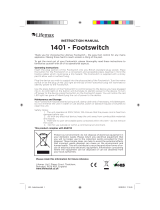
6
171819202122
232425262728
(17) MIDI IN/FOOTSWITCH
is 8-pin DIN connector is provided for the connection of the remote footcontroller. See the FOOTSWITCH
section of this manual for a more detailed explanation of operation. is can also be used as a MIDI IN connec-
tion, using a standard 5-pin MIDI cable, if the amp is going to be controlled by a separate MIDI controller other
than the supplied footcontroller. See the MIDI section of this manual for a more detailed explanation of the
MIDI features.
(18) MIDI OUT
is 5-pin DIN connector is provided to send MIDI messages, including Program Change and Continuous Con-
troller messages, to external MIDI devices. It is useful for linking two amps and keeping their functions synchro-
nized, and for sending your custom preset data to another amp or MIDI backup device. It’s also useful to control
presets on eects units you may have in the eects loops. See the MIDI section of this manual for a more detailed
explanation of the MIDI features.
(19) 9VDC AUX POWER SUPPLY
ese pedal-standard, 9VDC (negative tip) barrel jacks are provided for quick power connection to a variety of
pedals or other peripheral devices. Each jack is capable of providing up to 500mA of current.
(20 and 21) EFFECTS LOOPS
ese series loops are used to route the Invective 120 signal path through external eects devices or signal pro-
cessors.
Note: the loops are aer the master boost, but before the master volume in the signal path. is allows the master
boost to not boost/cut ambient eects trails.
(22) MASTER BOOST
is control sets the amount of footswitchable post-EQ volume boost available with a range of 0-5dBV.
Note: this control is before the eects loops in the signal path.
REAR PANEL
POWER
SUPPLY
4
16
8
32
FUSE
60 Hz
300 WATTS
MSDI
MASTER BOOST
(NEGATIVE TIP)
RETURN
SEND
RETURN
FOOT-
SWITCH IN
OUTPUT
MICROPHONE SIMULATED
DIRECT INTERFACE
OUT/
THRU
LEVEL
IMPEDANCE
OUTPUT
POWER
FULL
FULL POWER
8 16
HALF
HALF POWER
LIFT
GROUND
LEVEL TONE
SPEAKER OUTPUTS
MIDI MIDI
44V RMS 4 MIN.
120W RMS/
SPEAKER JACKS PARALLELED
CLASS 2 WIRING
CAUTION
WARNING:
APPARATUS SHOULD NOT BE EXPOSED TO RAIN OR MOISTURE AND
HAZARD, REPLACE WITH SAME TYPE 250 VOLT FUSE.
TO REDUCE THE RISK OF FIRE OR ELECTRIC SHOCK, THIS
DANS LE BUT DE REDUIRE LES RISQUES D’INCENDIE OU DE
AVIS:
A LA PLUIE OU A L’HUMIDITE ET AUCUN OBJET REMPLI DE LIQUIDE,
DECHARGE ELECTRIQUE, CET APPAREIL NE DOIT PAS ETRE EXPOSE
TEL QU’UN VASE, NE DOIT ETRE POSE SUR CELUI-CI. REMPLACER
PAR UN FUSIBLE DE MEME TYPE ET DE 250 VOLTS.
AVIS:
RISQUE DE CHOC ELECTRIQUE NE PAS OUVRIR
OBJECTS FILLED WITH LIQUIDS, SUCH AS VASES, SHOULD NOT
BE PLACED ON THIS APPARATUS. TO PREVENT THE RISK OF FIRE
SEND
F5AL/250V
120V
Consumo de energia 300Wh
Consumo de energia
en modo de espera 92Wh
CAN-ICES-3(B)/NMB-3(B)
ENGINEERED IN USA
DESIGNED AND
A PRODUCT OF PEAVEY
ELECTRONICS CORP.
www.peavey.com
9VDC @ 500mA
EFFECTS LOOP 1
EFFECTS LOOP 2
0 10
1 9
2 8
3 7
4
5
6
0 10
1 9
2 8
3 7
4
5
6
4
16
8
32
FUSE
60 Hz
300 WATTS
MSDI
MASTER BOOST
(NEGATIVE TIP)
RETURN
SEND
RETURN
FOOT-
SWITCH IN
OUTPUT
DIRECT INTERFACE
IMPEDANCE
OUTPUT
POWER
FULL
FULL POWER
8 16
HALF
HALF POWER
LIFT
GROUND
TONE
44V RMS 4 MIN.
120W RMS/
SPEAKER JACKS PARALLELED
CLASS 2 WIRING
CAUTION
WARNING:
APPARATUS SHOULD NOT BE EXPOSED TO RAIN OR MOISTURE AND
HAZARD, REPLACE WITH SAME TYPE 250 VOLT FUSE.
TO REDUCE THE RISK OF FIRE OR ELECTRIC SHOCK, THIS
DANS LE BUT DE REDUIRE LES RISQUES D’INCENDIE OU DE
AVIS:
A LA PLUIE OU A L’HUMIDITE ET AUCUN OBJET REMPLI DE LIQUIDE,
DECHARGE ELECTRIQUE, CET APPAREIL NE DOIT PAS ETRE EXPOSE
TEL QU’UN VASE, NE DOIT ETRE POSE SUR CELUI-CI. REMPLACER
PAR UN FUSIBLE DE MEME TYPE ET DE 250 VOLTS.
AVIS:
RISQUE DE CHOC ELECTRIQUE NE PAS OUVRIR
OBJECTS FILLED WITH LIQUIDS, SUCH AS VASES, SHOULD NOT
BE PLACED ON THIS APPARATUS. TO PREVENT THE RISK OF FIRE
SEND
F5AL/250V
120V
Consumo de energia 300Wh
Consumo de energia
en modo de espera 92Wh
CAN-ICES-3(B)/NMB-3(B)
ENGINEERED IN USA
DESIGNED AND
A PRODUCT OF PEAVEY
ELECTRONICS CORP.
www.peavey.com
9VDC @ 500mA
EFFECTS LOOP 1
EFFECTS LOOP 2
0 10
1 9
2 8
3 7
4
5
6
0 10
1 9
2 8
3 7
4
5
6





















